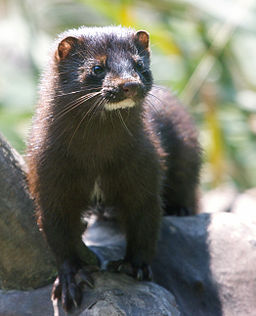Identification | Biology | Damage ID | Management | Handling
Identification
The mink (Neovision vison) is a member of the weasel family.
Legal Status
Mink are protected fur bearers in most states, with seasons established for taking them when their fur is prime. Most states, however, have provisions for landowners to control fur bearers which are damaging their property at any time of the year. Check with your state wildlife agency before using any lethal controls.
Physical Description
It is about 18 to 24 inches in length, including the somewhat bushy 5- to 7-inch tail, and weighs 1½ to 3 pounds. Females are about ¾ the size of males. Both sexes are a rich chocolate-brown color, usually with a white patch on the chest or chin and scattered white patches on the belly. The fur is relatively short with the coat consisting of a soft, dense underfur concealed by glossy, lustrous guard hairs. Mink also have anal musk glands common to the weasel family and can discharge a disagreeable musk if frightened or disturbed. Unlike skunks, however, they cannot forcibly spray musk.
Species Range
Mink are found throughout North America, with the exception of the desert southwest and tundra areas.

Voice and Sounds
Mink emit various sounds including, defensive screams, squeaks for warning, and hissing. They may chuckle during the mating season.
Tracks and Signs
Tracks of mink are subtle but a careful eye can find them in soft soils around waterways.
Acknowledgements
Information on this species is based on the chapter in Prevention and Control of Wildlife Damage (Hygnstrom, Larson, Timm, ed. 1994), written by Edward K. Boggess (Minnesota Department of Natural Resources).
